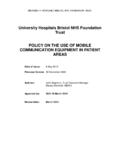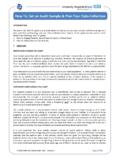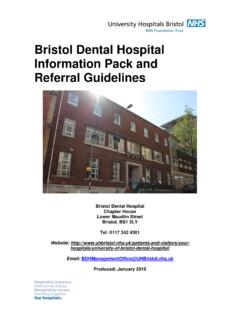Transcription of How To: Involve Patients, Service Users & Carers in ...
1 2009 UHBristol Clinical Audit Team Version 3 Page 1 of 7 INTRODUCTION The aim of this How To guide is to provide advice on how to Involve patients , Service Users and Carers in the clinical audit process. The Healthcare Quality Improvement Partnership (HQIP) state that the involvement and engagement of patients , Service Users and Carers in clinical audit is vital and is a marker of high quality audit. If you are thinking about involving patients , Service Users and/or Carers in your project it is important that you discuss this with your divisional Clinical Audit Facilitator at the planning stage. Aspects of this guide are discussed in more detail in: How To: Set an Audit Sample and Design your Data Collection & Data Collection Form.
2 How To: Apply Ethics to Clinical Audit THE ENGAGEMENT AGENDA Clinical audit must include patients . They, as well as clinicians, are the true professionals in illness. The doctor may be highly qualified to diagnose and give treatment. However, only the patients truly know the pain, physical and psychological, and the stress of their illness. The patient s voice is so valuable as part of the audit . The engagement agenda within the NHS is seen to enhance the quality of healthcare services by ensuring that they are oriented, planned and delivered to meet patient needs and interests. In particular involving patients in clinical audit provides a mechanism by which NHS organisations can show that what is being measured actually matters to patients .
3 The Department of Health has published a range of guidance and legislation that places the engagement agenda at the heart of improving quality within the NHS. This documentation is aimed at ensuring that patient involvement is incorporated into the way in which NHS organisations make decisions and improve services . Key Department of Health documents are: Iain Thomas, MINAP representative, Member of the SW London Cardiac and Stroke Network HQIP, Patient & Public Engagement (PPE), PPE in Clinical Audit 2009 Patient and Public Involvement in the New NHS (1999) - This document places involvement at the centre of NHS policy stating that health organisations need to work with patients , Service Users , their Carers and local communities to develop ways of improving health and making services and care responsive to individuals and local communities needs.
4 Patient and Public Involvement Forums (PPIFs) (2003) A PPIF was established as an independent statutory body for each NHS trust and PCT in England. The aim of the PPIFs was to improve the quality of NHS services by representing the views and experiences of patients , their Carers and families, through monitoring and reviewing NHS delivery, seeking the views of the public about those services and making recommendations to the NHS accordingly. NHS Act, 2006 - Section 242 of the Act, states that all NHS organisations have a duty to Involve by ensuring that arrangements are in place so that the persons to whom those services are being or may be provided are, directly or through representatives, involved in and consulted on the planning of the provision of those services , the development and consideration of proposals for changes in the way those services are provided, and decisions to be made by that body affecting the operation of those services .
5 Health and Social Care Act (2007) and Local Involvement Networks (LINks) - The Act reiterated that patient and public engagement should be part of the core business of every NHS organisation and How To: Involve patients , Service Users & Carers in Clinical Audit 2009 UHBristol Clinical Audit Team Version 3 Page 2 of 7 How To: Involve patients , Service Users & Carers in Clinical Audit replaced PPIFs with LINks. LINks are independently run by agencies or charitable groups with the aim of giving local citizens a voice and the authority to monitor local services and hold providers to account. High Quality Care for All: NHS Next Stage Review (2008) - Lord Darzi s report emphasised the need for high quality care for patients and the public and the need to work in partnership.
6 By stating that measuring and valuing what matters most to patients , the public and staff is the way in which we will enable the NHS to make progress towards high quality care . World Class Commissioning (2009) - World class commissioning aims to use best practice from across the world to help PCTs deliver better health and well-being for their population. Competency three states that this should mean to; proactively build continuous and meaningful engagement with the public and patients to shape services and improve health . The NHS Constitution (2009) - The NHS Constitution pledged that patients have the right to be involved in discussions and decisions about their healthcare, and to be given information to enable them to do this; and the right to be involved, directly or through representatives, in the planning of healthcare services , the development and consideration of proposals for changes in the way those services are provided, and in decisions to be made affecting the operation of those services .
7 The patient s voice is so important but do not forget the carer. There are about six million voluntary Carers , relatives and friends of all ages, in the UK. They have more experience than a doctor of a patient s pain, problems and care needs. They are the unrecognised figures in dealing with patients , their views should be brought into the open through audit . Sirkka Thomas, Former Health Visitor and Cardiac, Nurse, now carer for her husband HQIP, Patient & Public Engagement (PPE), PPE in Clinical Audit 2009 THE BENEFITS OF ENGAGEMENT IN CLINICAL AUDIT HQIP states that patients need to be involved and engaged in the selection of initiatives to improve quality; in the governance of these initiatives, such as a clinical audit; in the collection of data for the audit; as part of the dissemination of the products to ensure, as consumers, they are provided with re-assurance and possible choice of healthcare provider, where such a choice is realistic or possible.
8 HQIP, Patient & Public Engagement (PPE), PPE in Clinical Audit 2009 Clinical audit is about improving the quality of clinical services given to patients . At UHBristol we believe that clinical audit should be focused on what matters most to our patients , Service Users and their Carers . For example, if outcomes are being audited, patients should be enabled to inform us about what outcome measures actually matter to them. THE BENEFITS The benefits of engagement as specified below are based upon those listed by HQIP in Patient & Public Engagement (PPE), PPE in Clinical Audit 2009. Those who have lived with, or cared for, someone with a particular illness are experts in the condition. They have a subjective and valid view point based on actual experience about where quality could, and should, be improved.
9 Through participation and engagement patients and Service Users can enhance clinical audit by achieving services better focused on their needs. A patient s or Service user s direct experience of care gives them a different perspective about ways to improve the quality of a Service compared to a clinician. patients might make different choices about which aspects of care should be included as standards to be measured through the clinical audit process. A patient can address the concerns they have raised by assisting with the development of the action plan. The patient s perspective will provide staff with a clearer picture about what changes 2009 UHBristol Clinical Audit Team Version 3 Page 3 of 7 How To: Involve patients , Service Users & Carers in Clinical Audit are needed and help to ensure that services are being provided in the way people want to see them.
10 Clinical audit results can provide patients and the public with more knowledge about the quality of care in a particular healthcare setting; enabling them to make more informed choices about where they obtain treatment. Public reporting should raise public confidence in the NHS as it boosts trust and satisfaction. Involvement in clinical audit should also provide patients with a deeper insight into care that is provided. However, it is important to remember that the communication of audit results should be done in such a way to ensure it is accessible to the public and easy to understand, written simply whereby the data and conclusions are easy to understand. Being involved in improving the quality of care through the clinical audit process can bring health benefits to patients ; feeling satisfaction after having influenced their care, being listened to, and from the social interaction and engagement that this offers.















